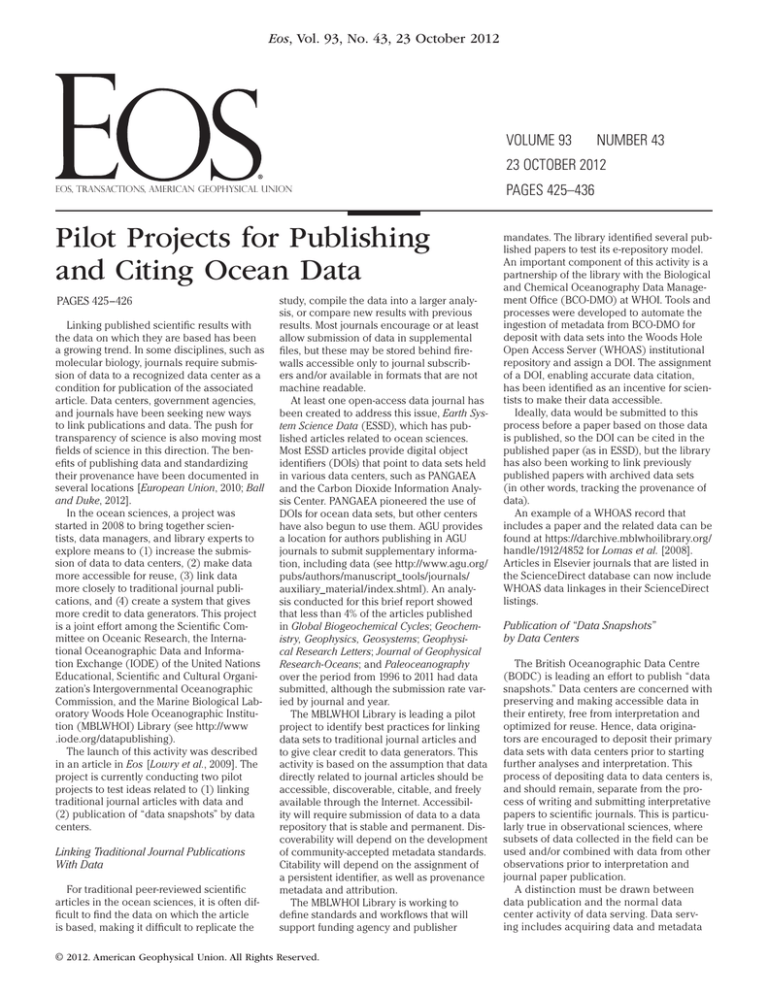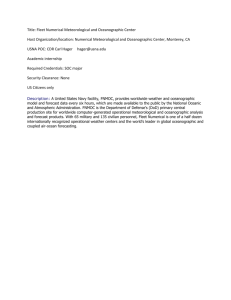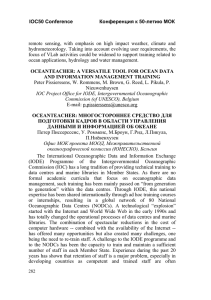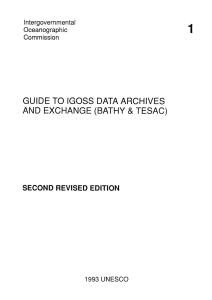
Eos, Vol. 93, No. 43, 23 October 2012
VOLUME 93
NUMBER 43
23 OCTOBER 2012
EOS, TRANSACTIONS, AMERICAN GEOPHYSICAL UNION
Pilot Projects for Publishing
and Citing Ocean Data
PAGES 425–426
Linking published scientific results with
the data on which they are based has been
a growing trend. In some disciplines, such as
molecular biology, journals require submission of data to a recognized data center as a
condition for publication of the associated
article. Data centers, government agencies,
and journals have been seeking new ways
to link publications and data. The push for
transparency of science is also moving most
fields of science in this direction. The benefits of publishing data and standardizing
their provenance have been documented in
several locations [European Union, 2010; Ball
and Duke, 2012].
In the ocean sciences, a project was
started in 2008 to bring together scientists, data managers, and library experts to
explore means to (1) increase the submission of data to data centers, (2) make data
more accessible for reuse, (3) link data
more closely to traditional journal publications, and (4) create a system that gives
more credit to data generators. This project
is a joint effort among the Scientific Committee on Oceanic Research, the International Oceanographic Data and Information Exchange (IODE) of the United Nations
Educational, Scientific and Cultural Organization’s Intergovernmental Oceanographic
Commission, and the Marine Biological Laboratory Woods Hole Oceanographic Institution (­MBLWHOI) Library (see http://w ww
.­iode.org/­datapublishing).
The launch of this activity was described
in an article in Eos [Lowry et al., 2009]. The
project is currently conducting two pilot
projects to test ideas related to (1) linking
traditional journal articles with data and
(2) publication of “data snapshots” by data
centers.
Linking Traditional Journal Publications
With Data
For traditional ­peer-­reviewed scientific
articles in the ocean sciences, it is often difficult to find the data on which the article
is based, making it difficult to replicate the
study, compile the data into a larger analysis, or compare new results with previous
results. Most journals encourage or at least
allow submission of data in supplemental
files, but these may be stored behind firewalls accessible only to journal subscribers and/or available in formats that are not
machine readable.
At least one ­open-­access data journal has
been created to address this issue, Earth System Science Data (ESSD), which has published articles related to ocean sciences.
Most ESSD articles provide digital object
identifiers (DOIs) that point to data sets held
in various data centers, such as ­PANGAEA
and the Carbon Dioxide Information Analysis Center. ­PANGAEA pioneered the use of
DOIs for ocean data sets, but other centers
have also begun to use them. AGU provides
a location for authors publishing in AGU
journals to submit supplementary information, including data (see http://w ww.agu.org/
pubs/­authors/­manuscript_tools/­journals/
­auxiliary_­material/­index.­shtml). An analysis conducted for this brief report showed
that less than 4% of the articles published
in Global Biogeochemical Cycles; Geochemistry, Geophysics, Geosystems; Geophysical Research Letters; Journal of Geophysical
­Research- ­Oceans; and Paleoceanography
over the period from 1996 to 2011 had data
submitted, although the submission rate varied by journal and year.
The ­MBLWHOI Library is leading a pilot
project to identify best practices for linking
data sets to traditional journal articles and
to give clear credit to data generators. This
activity is based on the assumption that data
directly related to journal articles should be
accessible, discoverable, citable, and freely
available through the Internet. Accessibility will require submission of data to a data
repository that is stable and permanent. Discoverability will depend on the development
of ­community-­accepted metadata standards.
Citability will depend on the assignment of
a persistent identifier, as well as provenance
metadata and attribution.
The ­MBLWHOI Library is working to
define standards and workflows that will
support funding agency and publisher
© 2012. American Geophysical Union. All Rights Reserved.
PAGES 425–436
mandates. The library identified several published papers to test its ­e -repository model.
An important component of this activity is a
partnership of the library with the Biological
and Chemical Oceanography Data Management Office (­BCO-DMO) at WHOI. Tools and
processes were developed to automate the
ingestion of metadata from ­BCO-DMO for
deposit with data sets into the Woods Hole
Open Access Server (­WHOAS) institutional
repository and assign a DOI. The assignment
of a DOI, enabling accurate data citation,
has been identified as an incentive for scientists to make their data accessible.
Ideally, data would be submitted to this
process before a paper based on those data
is published, so the DOI can be cited in the
published paper (as in ESSD), but the library
has also been working to link previously
published papers with archived data sets
(in other words, tracking the provenance of
data).
An example of a WHOAS record that
includes a paper and the related data can be
found at https://­darchive.­mblwhoilibrary.org/
­handle/1912/4852 for Lomas et al. [2008].
Articles in Elsevier journals that are listed in
the ­ScienceDirect database can now include
­WHOAS data linkages in their ­ScienceDirect
listings.
Publication of “Data Snapshots”
by Data Centers
The British Oceanographic Data Centre
(BODC) is leading an effort to publish “data
snapshots.” Data centers are concerned with
preserving and making accessible data in
their entirety, free from interpretation and
optimized for reuse. Hence, data originators are encouraged to deposit their primary
data sets with data centers prior to starting
further analyses and interpretation. This
process of depositing data to data centers is,
and should remain, separate from the process of writing and submitting interpretative
papers to scientific journals. This is particularly true in observational sciences, where
subsets of data collected in the field can be
used and/or combined with data from other
observations prior to interpretation and
journal paper publication.
A distinction must be drawn between
data publication and the normal data
center activity of data serving. Data serving includes acquiring data and metadata
Eos, Vol. 93, No. 43, 23 October 2012
from the originating scientists, harmonizing metadata and data file format prior to
database ingestion, ensuring that metadata
are adequate and accurate and that the
data are available in appropriate file formats, and making the most up-to-date version of the data available for interested parties. Data publication, however, requires
the assignment of persistent identifiers
and the guarantee that the data center will
maintain an unchanged version of the data
for the foreseeable future. As part of this
publication process, data centers will be
expected to assess the quality of the metadata and the suitability of the file format.
BODC staff members have created the prototype BODC Published Data Library (PDL),
which provides snapshots of specially chosen data sets that are archived using rigorous version management. This enables citation in journal articles through the assignment of a DOI in collaboration with the British Library (https://w ww.bodc.ac.uk/­data/
­published_d
­ ata_­library/). Data sets selected
for inclusion in the PDL are those that are
likely to have application beyond a single
publication. This makes citation of these
data sets by researchers easier: Rather than
having to link various data sets (sometimes
hundreds or thousands of observations
from various sources), they can use the prepacked set and link it to their papers. Data
sets will include both those already ingested
by BODC as well as those that will be
ingested in the future. The PDL catalog can
be found at https://w ww.bodc.ac.uk/­data/
­published_­data_­library/­catalogue/.
Next Steps
Work is continuing on these two activities with the objective of further refining
the procedures and eventually mainstreaming these services throughout the research
and academic community. To achieve the
latter goal, the activities will be widely
publicized through participation in relevant conferences. In addition, a “cookbook” is planned to enable other libraries and national data centers to establish
similar systems, using best practices. IODE
will be implementing a Published Ocean
Data system to provide a repository for data
from scientists who do not have access
to a national oceanographic data center.
IODE is also surveying its members to discover national activities on data publication. The group will continue to work with
the Data Citation Standards and Practices
Task Group of the Committee on Data for
Science and Technology, of the International Council for Science (see http://w ww
.­codata.org/­taskgroups/­TGdatacitation/
­index.html).
© 2012. American Geophysical Union. All Rights Reserved.
References
Ball, A., and M. Duke (2012), How to Cite Datasets
and Link to Publications, http://w ww.dcc.ac.uk/
­webfm_ send/­525, Digital Curation Cent., Edinburgh.
European Union (2010), Riding the wave: How
Europe can gain from the rising tide of scientific
data, final report, Brussels. [Available at http://
­cordis.­europa.eu/fp7/ict/e -­infrastructure/docs/
hlg- sdi-­report.pdf.]
Lomas, M. W., F. Lipschultz, D. M. Nelson, J. W.
Krause, and N. R. Bates (2008), Biogeochemical
responses to ­late-­winter storms in the Sargasso
Sea, I—Pulses of primary and new production,
Deep Sea Res., Part II, 56, 843–860, doi: 10.1016/
j.dsr.2008.09.002.
Lowry, R., E. Urban, and P. Pissierssens (2009),
A new approach to data publication in ocean Sciences, Eos Trans. AGU, 90(50), 484, doi:10.1029/
2009EO500004.
—Ed Urban, Scientific Committee on Oceanic
Research, University of Delaware, Newark; ­E-mail:
ed.urban@­scor-int.org; Adam Leadbetter and
Gwenaelle Moncoiffe, British Oceanographic
Data Centre, Liverpool, UK; Peter Pissierssens,
Intergovernmental Oceanographic Commission
Project Office for the International Oceanographic
Data and Information Exchange, Oostende, Belgium;
Lisa Raymond, Marine Biological Laboratory Woods
Hole Oceanographic Institution Library, Woods Hole,
Mass.; and Linda Pikula, Miami Regional Library
Atlantic Oceanographic and Meteorological Laboratory, and National Hurricane Center, Miami, Fla.







